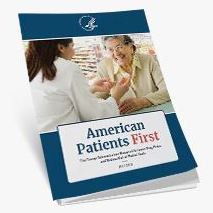 In May of this year, the Trump White House issued its “Blueprint to Lower Drug Prices” in response to the Administration’s views that excessively high drug prices “burdening the American people” were in part caused by “foreign freeloading” and a system currently rigged “to reward list price increases.”
In May of this year, the Trump White House issued its “Blueprint to Lower Drug Prices” in response to the Administration’s views that excessively high drug prices “burdening the American people” were in part caused by “foreign freeloading” and a system currently rigged “to reward list price increases.”
The policy document, which was open for public comment until mid-July, advocated a variety of policies falling under five broad strategies:
- Make drug prices and price increases more transparent to consumers;
- Foster competition through support of wider usage of generic and biosimilar drugs and criticism of anti-competitive company practices and foreign drug costs;
- Give Medicare greater leverage to negotiate prices of certain drugs with manufacturers
- Push to end the system of rebates to drug middle-marketers and insurers; and
- Reduce regulation and enact incentives for lower drug list prices, including value-based pricing, with the goal of lowering out-of-pocket costs for patients.
The proposals outlined are intended to encourage innovation while promoting better price competition for prescription drugs and addressing what the administration sees as unfair practices by other countries using socialized healthcare to command low prices from U.S. drug makers, thus putting the cost burden of drug innovation on the American people.
Reactions from key audiences have been mixed. Most of the groups commenting have been generally positive on proposals aimed at increasing the use of generic drugs and promoting a more competitive market for biosimilars. And indeed, as we wrote a few weeks ago, efforts by the U.S. Food and Drug Administration are already underway to better educate physicians and patients about biosimilars. In addition, the Centers for Medicare and Medicaid Services are making changes in reimbursement policies to help incentivize greater biosimilar use.
The concept of value-based pricing was also widely popular with different groups of commenters, although such strategies will require greater incorporation of Real World Evidence to demonstrate value — something that is still a challenge. There was furthermore considerable support for increasing drug pricing transparency, as well as for more and better patient information on medications and costs which can be easily understood and actionable, without placing too much decision-making responsibility on patients alone.
 However, insurance industry trade group America’s Health Insurance Plans (AHIP) objected to the Administration’s suggestion that insurers may be favoring drugs with high prices and high rebates at the expense of lower cost products. AHIP also disagreed with the idea that incentives alone could produce cost reductions, adding that this could only happen if health plans can leverage competition from drug manufacturers. Pharmacy benefit managers also urged the government not to alter the drug rebate system, which according to them is essential to negotiate lower drug prices. The rebate system, however, is already a main target of the Trump Administration, with Health and Human Services Secretary Alex Azar making changes to this pricing strategy as one of his top priorities.
However, insurance industry trade group America’s Health Insurance Plans (AHIP) objected to the Administration’s suggestion that insurers may be favoring drugs with high prices and high rebates at the expense of lower cost products. AHIP also disagreed with the idea that incentives alone could produce cost reductions, adding that this could only happen if health plans can leverage competition from drug manufacturers. Pharmacy benefit managers also urged the government not to alter the drug rebate system, which according to them is essential to negotiate lower drug prices. The rebate system, however, is already a main target of the Trump Administration, with Health and Human Services Secretary Alex Azar making changes to this pricing strategy as one of his top priorities.
Physicians — represented by the American Medical Association (AMA) — commented that governmental solutions to high prices may shift costs from one set of patients to another as a result of higher across-the-board premiums. They also voiced concerns about possible onerous insurer paperwork requirements that could interfere with patient access to medications and treatments, as well as new policies that might financially penalize physicians and pharmacists.
The Patient Access Network and 52 other patient advocacy organizations expressed concerns about maintaining patient access to prescribed treatments. They noted that the high cost of important medications leads to problems with patient adherence to treatment, which subsequently leads to worse health outcomes. They felt it would be essential for all drug cost-cutting proposals affecting both publicly funded and commercial insurance plans to include safety net subsidiaries to support underserved patients — and that this concept had not been sufficiently addressed in the Blueprint. They also recommended that Health and Human Services investigate drivers of medication non-adherence, as well as how such factors affect underserved patient populations, and look for solutions to those problems.
Pharmaceutical companies represented by PhRMA called on the Administration not to move drugs from Medicare Part B to Part D and rejected the idea of listing drug prices on advertising aimed at consumers. But they supported the Administration’s criticism of price controls by foreign governments which drive up drug prices in the United States, where drug pricing is not regulated.
We wonder which proposals in the Blueprint will actually be implemented and whether such actions would ultimately have a drug price lowering effect.